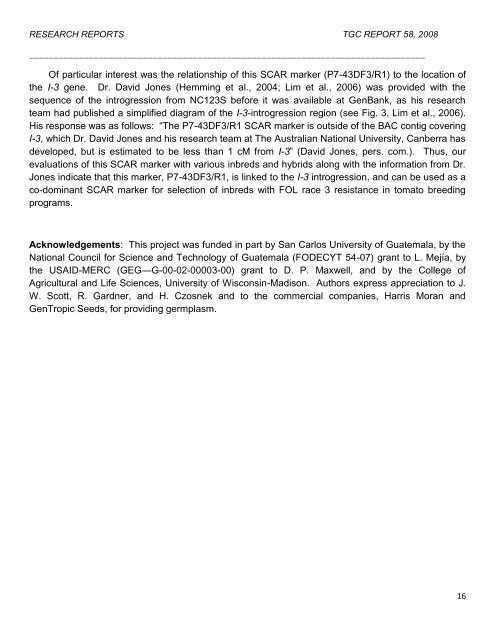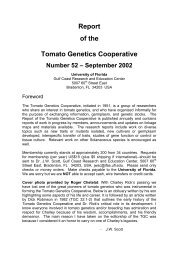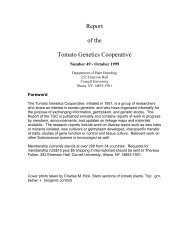Report of the Tomato Genetics Cooperative Number 58
Report of the Tomato Genetics Cooperative Number 58
Report of the Tomato Genetics Cooperative Number 58
Create successful ePaper yourself
Turn your PDF publications into a flip-book with our unique Google optimized e-Paper software.
RESEARCH REPORTS TGC REPORT <strong>58</strong>, 2008<br />
________________________________________________________________________________<br />
Of particular interest was <strong>the</strong> relationship <strong>of</strong> this SCAR marker (P7-43DF3/R1) to <strong>the</strong> location <strong>of</strong><br />
<strong>the</strong> I-3 gene. Dr. David Jones (Hemming et al., 2004; Lim et al., 2006) was provided with <strong>the</strong><br />
sequence <strong>of</strong> <strong>the</strong> introgression from NC123S before it was available at GenBank, as his research<br />
team had published a simplified diagram <strong>of</strong> <strong>the</strong> I-3-introgression region (see Fig. 3, Lim et al., 2006).<br />
His response was as follows: ―The P7-43DF3/R1 SCAR marker is outside <strong>of</strong> <strong>the</strong> BAC contig covering<br />
I-3, which Dr. David Jones and his research team at The Australian National University, Canberra has<br />
developed, but is estimated to be less than 1 cM from I-3‖ (David Jones, pers. com.). Thus, our<br />
evaluations <strong>of</strong> this SCAR marker with various inbreds and hybrids along with <strong>the</strong> information from Dr.<br />
Jones indicate that this marker, P7-43DF3/R1, is linked to <strong>the</strong> I-3 introgression, and can be used as a<br />
co-dominant SCAR marker for selection <strong>of</strong> inbreds with FOL race 3 resistance in tomato breeding<br />
programs.<br />
Acknowledgements: This project was funded in part by San Carlos University <strong>of</strong> Guatemala, by <strong>the</strong><br />
National Council for Science and Technology <strong>of</strong> Guatemala (FODECYT 54-07) grant to L. Mejía, by<br />
<strong>the</strong> USAID-MERC (GEG—G-00-02-00003-00) grant to D. P. Maxwell, and by <strong>the</strong> College <strong>of</strong><br />
Agricultural and Life Sciences, University <strong>of</strong> Wisconsin-Madison. Authors express appreciation to J.<br />
W. Scott, R. Gardner, and H. Czosnek and to <strong>the</strong> commercial companies, Harris Moran and<br />
GenTropic Seeds, for providing germplasm.<br />
16





